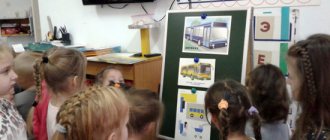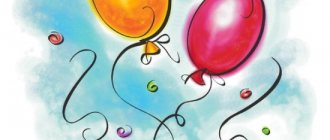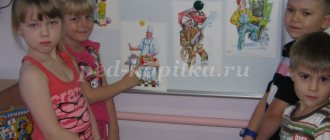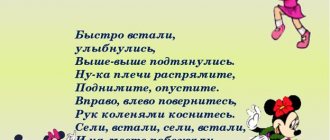Summary of the drawing lesson “Bus”. Middle group
Yulia Essina
Summary of the drawing lesson “Bus”. Middle group
Abstract on the educational field “artistic and aesthetic development”
Drawing ( middle group )
Topic: " Bus "
Educator: Essina Yu. V.
Goal: to teach children to convey rectangular, square and round shapes in a drawing, to draw an object large , in accordance with the size of a sheet of paper, to maintain proportions.
1. To develop children’s knowledge about transport and its types; convey the shape of the main parts of the parts, their size and location.
2. Form rules for painting with paints: in one direction (from left to right or from top to bottom)
with the entire brush, tearing it off the paper and each time bringing it to the outline.
3. To develop interest in drawing , artistic taste, attention and logical design in drawing , creative thinking and imagination.
4. Continue to develop the ability to evaluate your own drawings and the drawings of other children.
5. Cultivate a desire to help other people.
Equipment and materials: pictures depicting various types of transport, album sheet, gouache, water jar, brush, napkin for each child.
Methods and techniques: a surprise moment, a teacher’s story, looking at illustrations, showing actions, asking questions to children.
Preliminary work: conversations about transport, looking at illustrations depicting transport, looking at transport toys.
Abstract of GCD “Truck” (drawing)
Abstract of GCD for children of senior preschool age for children with mental retardation
“Truck” (draw according to the template)
Goal: To teach children to think through a plan for the upcoming work, speaking it in a whisper.
Objectives: Improving self-control during independent verbal planning of work on a drawing.
Preliminary work:
Conversation “Ground transport”.
D/game “Streets of our city”.
S/r game "Driver".
Progress of the lesson:
Educator.
Guys, do you know that our world consists of many objects, things, and if you look at them carefully, you can see that they all have a certain shape. What geometric shapes do you know? (oval, circle, triangle, square, etc.)
The teacher shows drawings - diagrams:
-The house consists of……(rectangle, triangle, square);
-Snowman from .....(three circles of different sizes, a triangle and a trapezoid);
- A Christmas tree made of... (three triangles and a rectangle).
The teacher invites the children to play the game “Assemble a car” and independently assemble geometric shapes.
-A machine made of ....(2 rectangles, squares, a triangle and two circles).
Educator.
Today we will create an image of an object from ready-made geometric shapes - templates. Like in a game, but only we will outline them, and as a result, from several details - templates - we will get an image of our car figure.
The sequence of our drawing.
First, we outline the main largest shape (rectangle - van or body);
We attach a smaller rectangle - the cabin (the side that is longer) so that each template is as close as possible to the previous shape.
And only then do we move on to the details: a triangular window near the cabin;
Two circles are wheels; rectangular - headlights and exhaust pipe.
We paint the finished car with colored pencils (paint in one direction with continuous back-and-forth movements, without skipping, evenly). If the color needs to be strengthened, paint it again. Encourages children for additional details (headlights, etc.).
Let's finish drawing the road.
I suggest you relax and hit the road.
Physical education
| On the street of our car, car. Small cars, big cars. Trucks are rushing, cars are snorting. They are in a hurry, rushing, as if they were alive. - Hey, cars, full speed ahead! I am an exemplary pedestrian: I don’t like to rush, I’ll give way to you. | Children move from one end of the group to the other, holding an imaginary steering wheel in their hands. They make a U-turn and move in the opposite direction. Marching |
Guys, now let's think about the sequence of the upcoming work.
Summary of drawing lesson “Bus”
Daria Afonina
Summary of drawing lesson “Bus”
"Bus". Lesson summary for an early age group.
Goal: To introduce children to passenger transport - a bus, and to give them an idea about it.
Objectives: -To strengthen the ability to hold a brush correctly;
-Develop attentiveness and perseverance, memory;
-instill interest in drawing;
-Develop the ability to carefully color a drawing without going beyond the contours;
Summary of GCD in the middle group
Objectives of the lesson.
Cognition: deepen and expand knowledge about ground transport. Learn to identify similar and different characteristics of passenger cars - size, color, shape; and car parts - trunk, hood, interior, wheels, steering wheel, etc. Give an idea of car models.
Communication: development of coherent speech. Activation, expansion of the dictionary.
Artistic creativity: develop the ability to paint over an image with plasticine - “Plasticineography”.
Material: models of cars of various brands (or pictures of cars, see Appendix). A5 cardboard with a picture of a passenger car for painting (see appendix).
GCD move.
A car horn sounds. The teacher attracts the children and leads them to the cars on display.
Educator: Today a car exhibition came to visit you. Look carefully at the cars and tell me what this type of transport is called?
Children: Land, passenger.
Educator: Correct. How do you think these cars are similar?
Children: All cars have wheels, headlights, hood, doors, interior, steering wheel, seats, trunk.
Educator: Correct. Now, guys, look and tell me, how are these cars different?
Children: All cars are different colors. Different shapes of trunk, headlights. Some cars have different numbers of doors.
Educator: Correct. Why do you think they are so different?
(children's assumptions)
Educator: Each plant produces different models of cars. Some people like black cars, some like red ones. If the family is large, then the number of seats in the car is needed. But some driver needs to transport cargo, for example, to the country, and he will choose a car with a large trunk. That’s why they produce different models of cars – for the convenience of people.
Educator: So who can tell me why the machines are different and why they do it? (The teacher listens to the answers of several children and praises them.)
Gymnastics for the eyes “Follow the movement of the car” is carried out.
Physical education lesson “ We’re going, we’re going home.”
We're going, we're going home (movements simulating turning the steering wheel)
By car
We drove up the hill: bang. (Hands up, clap overhead)
The tire goes flat: stop. (Arms downwards, squat)
At the tables.
Educator: Now I will give you images of a passenger car, but it is not painted and you will need to color it. And we will paint with plasticine. Who remembers how this is done? (Children's answers).
We remind the teacher how to work with plasticine: pinch off a piece and distribute it over the image. We don't go beyond the lines.
Educator: Guys, we found out that cars come in different colors, depending on who you like. Therefore, you choose the color of the car yourself. What won't we paint over? (Window). Well done, get to work.
At the end of the activity, a work analysis is carried out. If the children do not have time to finish the work, it can be continued in the evening.
On the topic: methodological developments, presentations and notes
By developing the cognitive interest of preschoolers through various types of activities, including visual arts, it is possible to achieve a significant increase in the level of ideas about the world around children. During the course
To cultivate a moral and aesthetic attitude through the depiction of animals.
This lesson introduces children to nature (trees and shrubs), allows them to teach children how to draw trees and shrubs correctly. The following methods were used in the lesson: gaming, verbal, practical.
Lesson notes on visual arts (modeling - experimentation). Topic: “Tili-tili dough...”
Lesson summary on visual arts (preparatory group) TOPIC: “Fairytale autumn forest.”
Source
Visual arts lesson on the topic “Bus”, middle group
Lesson summary for visual arts in the middle group
" Bus"
Target
: teach children to convey rectangular and round shapes in a drawing, draw an object large, in accordance with the size of a sheet of paper, and maintain proportions.
Tasks
:
1. To develop children’s knowledge about transport and its types; convey the shape of the main parts of the parts, their size and location.
2. Form rules for painting with paints: in one direction (from left to right or from top to bottom) with the entire brush, tearing it off the paper and each time bringing it to the outline.
3. To develop interest in drawing, artistic taste, attention and logical design in drawing, creative thinking and imagination.
Handout:
Landscape sheet, gouache, bus drawing algorithm, toy bus, video presentation depicting transport (plane, helicopter, bus, trolleybus, tram, ship).
Preliminary work
:, conversations about transport, looking at illustrations depicting transport, looking at transport toys.
Progress of the lesson:
Organizing time:
The guys came to visit us. But we need to guess what type of transport they arrived on. To find out, you need to solve the riddle. The teacher asks you to guess the riddle:
A strange house rushes along the road -
Round rubber feet.
filled with passengers
And the tank is filled with gasoline... (bus)
- Children, let's look carefully in the group and find out if we have a bus.
When the children find the bus, they sit in a semicircle on chairs near the TV.
Main part: Video presentation “transport”
- Now I will show you pictures of transport, and you will say the name of this transport. (I show and the children name). Well done. Now let's remember the types of transport. What type of transport is a ship?
(Water)
- Why?
(Because he floats on water)
- Well done. Bus, tram and trolleybus - what type of transport is this?
(Terrestrial because it moves on the ground).
- Fine. Plane and helicopter - what type of transport?
(
Aerial because they fly through the air).
- Right.
Today we will draw a representative of a terrestrial species - a bus. Let's look at and touch our bus, remember what parts the bus consists of, I will show the parts of the bus, and you will name them. (
Wheels, windows, doors, headlights).
- Fine. Why does a bus need windows?
(
So that people can see where they are going).
— Why does the bus need doors?
(
To board and disembark passengers at stops).
- That's right, but why does he need wheels?
(
To move along the road).
— Why do the bus have headlights?
So he can ride in the dark).
- Well done.
- Show and name the geometric shapes that the parts of the bus look like:
What shape do the doors look like? ( rectangular
)
What shape do windows look like? ( square
)
What shape do the wheels look like? ( round
)
- Well done!
It's time for us to go to the creative workshop. Let's go.
Outdoor game "Bus":
Our bus goes on and on, spinning and spinning its wheel. (rotate clenched fists)
Our bus goes and goes, Turns, turns the steering wheel, the steering wheel
(we depict how we turn the steering wheel)
Our bus goes and goes, With windshield wipers, bzhik-bzhik bzhik-bzhik
(parallel with both hands left and right)
Our bus goes, twists, turns the wheel.
Doors open, doors close. (we bring our palms together and separate them)
Our bus goes and goes, Spins, spins the wheel.
Our bus is coming and going. Everyone beeps beep (we press on our nose).
Children do the exercise and sit down at the tables. Demonstration of an algorithm for drawing a bus on a magnetic board.
Explanation and demonstration to children how to draw a bus from geometric shapes, showing the sequence of the image of the bus. (draw in the air)
1. First, let's draw a rectangle. We paint it from left to right with the entire bristle of the brush. This will be the main part of the bus. 2. From the upper left corner, draw an arc to the upper right corner with the whole brush. The result is a solon of a bus, then we draw vertical straight lines to make the windows. 3. Now we draw two wheels (circles). We paint the wheels black in a circle.
- Let's paint the buses in different colors, think about what two colors you want to choose and take the jars of paint on the table.
Children's work.
- Now think about how you would like to decorate and complement your drawing, for example, you can draw a road along which a bus is traveling or the sun in the sky.
Bottom line
:
Children show their works and talk about them.
Encouraging children.
Summary of OOD on drawing in the middle group of children on the topic “Transport”
Daria Tokareva
Summary of OOD on drawing in the middle group of children on the topic “Transport”
Summary of OOD on drawing in the middle group of children on the topic “ Transport ”
Completed by Tokareva D.N., teacher at MBDOU “Kindergarten of compensatory type No. 4”
,Voronezh city
-develop visual perception of color and size;
-develop memory, thinking, attention;
- evoke positive emotions in children ;
- learn to work carefully with paints;
- be respectful of the results of the creativity of your peers.
-improve the technique of using a brush (the end of the brush, the brush with a poke)
;
- develop fine motor skills of the hands;
-development and activation of the dictionary;
-develop auditory attention, coordination of speech with movement.
- make sentences based on pictures.
-control children’s posture while drawing ;
- physical minute “We’re going, we’re going by car...”
;
- didactic game “The fourth odd one”
;
-articulation gymnastics “Door”
,
“Clock”
,
“Woodpecker”
,
“Motor”
).
Methodological techniques, surprise moment, questions, game, use of PC,
reminder, individual assistance.
Preliminary work: -in individual lessons we read poems about transport , learned riddles;







